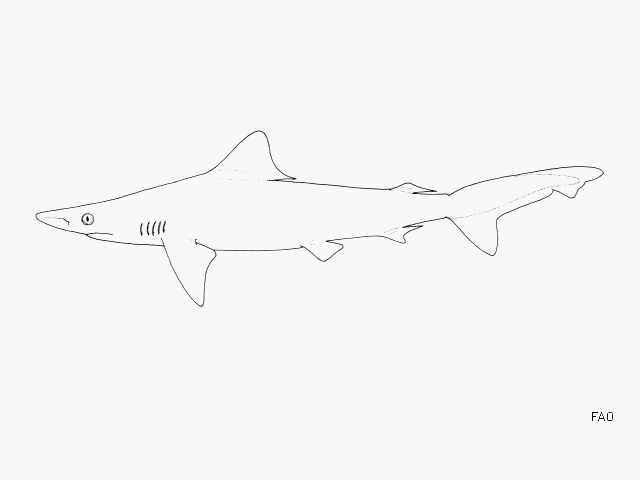| Carcharhinidae (Requiem sharks) |
| 70 cm TL (male/unsexed) |
|
demersal; marine |
| Western Pacific: Borneo and China. Questionably occurring in Java, Indonesia and the Philippines. Due to its very restricted and very small area of occurrence (Borneo), conservation measures are urgently needed (Ref. 84280). |
|
This small species is characterized by the following: snout long and pointed; slender body and tail; alongside each mouth corner is a row of enlarged hyomandibular pores (5-12); upper anterior teeth finely serrated with a single narrow, oblique cusp; distal edge deeply notched and with several cusplets; lower anterior teeth with narrower, similarly oblique cusps; no lateral cusplets; total tooth row counts 23-26/23-25, or 46-50; second dorsal-fin origin well posterior of anal-fin origin, about opposite or just anterior to anal-fin midbase while second dorsal-fin
origin to anal-fin origin 2.2-4.1% TL, 0.4-0.9 times second dorsal-fin base; interdorsal space 20.7-22.7% TL; pelvic fins small, anterior margins 4.4-5.8% TL and 35-42% of pectoral anterior margin; first dorsal fin triangular, with nearly straight posterior margin, free rear tip about opposite pelvic-fin origins, length 14.5-17.6% TL, 1.8-2.4 times height, inner margin 1.9-2.8 in base; second dorsal fin much smaller than first and slightly smaller than anal fin, length 7.5-10.2% TL, base 2.0-3.1 times height; height 21-29% of first dorsal fin height; anal fin height 1.1-1.6 times second dorsal height, base 1.1-1.5 times second dorsal-fin base; total vertebral counts 117-121, monospondylous precaudal counts 33-36, diplospondylous precaudal counts 21-26, diplospondylous caudal counts 56-60, precaudal counts 57-63; colour slate-grey dorsally, whitish ventrally with waterline clearly demarcated along head and body, fins no distinct black markings, pectoral fins and lower caudal lobe with whitish margins (Ref. 84280). |
| A rare species found inshore in coastal areas (Ref. 244). Viviparous (Ref. 50449). Specimens range in length from 23.7-61.8 cm TL. Two specimens collected in the 1800s had fresh umbilical scars at 23.7 and 27.4 cm, indicating that the size at birth is close to these sizes; four specimens of 34.1-37.3 cm had well healed, but still obvious umbilical scars. Five males with lengths of 54.8-57.6 cm were found mature (additional material of mature males with lengths of 59.0-62.0 cm and several pregnant females with lengths of 61.0-65.0 cm). Litter size of pregnant females was 6 (Ref. 84280). Undoubtedly taken in local fisheries (Ref. 244). |
|
Critically Endangered (CR); Date assessed: 31 October 2020 (A2cd) Ref. (130435)
|
| harmless |
Source and more info: www.fishbase.org. For personal, classroom, and other internal use only. Not for publication.
